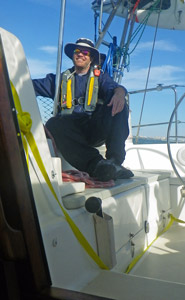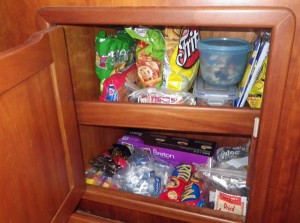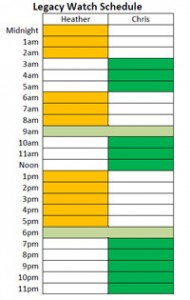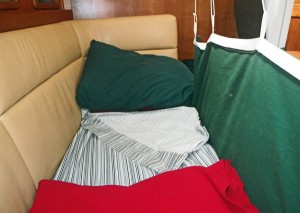I’m going to stray a bit off topic today and talk about passage-making. Much has been written about provisioning and preparations for ocean passages, but most of the passages that cruisers make (especially in Pacific Mexico) are shorter. We typically make passages of 18 – 72 hours, with occasional 4 – 6 day passages.
Food: First, let’s talk about food – since this IS the Cruising Cook’s blog! Right off I’ll let you know that I rarely cook on passage! Typically there are just two of us aboard, so if I’m cooking while on watch I’m constantly running up and down the stairs to check the horizon and the sails. If I’m off watch, any cooking I do is cutting into my sleep time. Instead, I stock the fridge and cabinets with easy to grab, easy to reheat foods. For a 2 – 3 day passage, I generally make a big pan of something and we’ll eat that for dinners and sometimes lunch as well. Some of my passage favorites are mac and cheese, shepard’s pie, quiche, chicken tetrazzini, and macaroni beef. I stay away from spicier dishes underway.
In addition to our main entrée, I often make muffins or cookies, hard boil eggs, pre-slice cheese (or stock string cheese), cut carrot sticks or fruit, and ensure that sandwich makings are close at hand. I arrange the fridge before a passage to make sure that all these foods and some drinks are easily accessible at the top. We also keep one designated “snack cabinet” on board. Anything in that cabinet is fair game at any time of the day or night. For passages, I’ll stock it with cookies, chips, nuts, trail mix, energy bars, crackers, microwave popcorn, chocolate, and hard candies. Sometimes, we carry microwavable cups of soup or noodles, especially in cooler climates. It’s important to stay hydrated on passage so we keep filled water bottles in the cockpit with a backup supply in the fridge for a cold water treat.
We arrange our watch schedule to overlap for two one-hour blocks each day – in the morning during the single sideband (SSB) nets and again at dinner time. It’s nice to be able to eat dinner together and chat about our day rather than just passing, bleary-eyed, at watch change time! Other than dinner, we eat whenever we feel like it and are responsible for getting our own meals or snacks. The person going off watch in the morning usually makes a pot of coffee before the “overlap” hour, but we get our own breakfasts whenever the urge strikes.
Crew Comfort: Because sleep is vitally important on passage, we set up a comfortable “nest” for the off-watch crew. Both settees have lee cloths, and we set them up before we leave the harbor. The port settee is for us, and we arrange it with a sheet, a fleece blanket, a couple of pillows, a fan, a light, and lots of ear plugs! We also like to have our headlamps available, both for on-deck use and for reading off-watch. Spare headlamp batteries are kept in a convenient location.
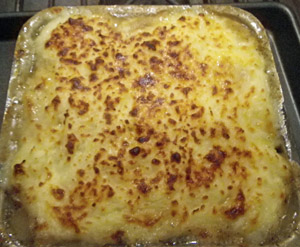
Shepherd’s pie (slightly crunchy mashed potatoes atop meat and vegetables in gravy) is another favorite on Legacy
We set up our starboard settee lee cloth as well, and this is a secure place for the dogs to hang out on passage. And, although we rarely use our forward Pullman berth underway, we also set up that lee cloth. The Pullman berth is where we stage everything we think we will need on passage, including a change of clothes, our daily medications, and warm gear for the cooler nighttime watches.
One other note about crew comfort: if you have ANY tendency to seasickness, we highly recommend that you take appropriate remedies BEFORE leaving the harbor. Although we rarely get seasick, we always use scopolamine patches for the first passage of the season, and for any passage that may be rough. And, we always choose our weather windows carefully to increase our odds of an easy passage.
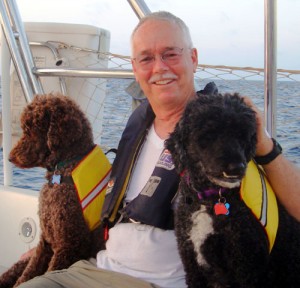
Charlie, Kira and Minnow wear their life jackets any time Legacy is underway as here while on passage to Ecuador.
Crew Safety: This category is the most important for the health and well-being of the crew. We have some basic safety rules which are always in effect. For one, no one leaves the cabin without a life vest when we are underway, including the dogs! In addition, from sunset to sunrise, anyone on deck must wear a safety tether connected to the jacklines. And if the on-watch crew has to go out of the cockpit in rough conditions or for anything major, they always wake up the off-watch crew and have them come on deck. During the hours of darkness, we keep the dogs belowdecks except for a supervised potty stop during watch change.
Although we always sail safely, when we first started cruising my biggest fear was that I would wake up from my off-watch nap and find that my partner was no longer aboard. To alleviate those fears, we added a Man Overboard (MOB) alert system. We both wear transmitters attached to our life vests. If the transmitter gets more than 50 or 100 feet from the base station, it sets off a loud alarm belowdecks. Since we installed that device, I sleep much more soundly off-watch.
One more note about safety: We strongly feel that cruising couples should set, and stick to, a watch schedule. We’ve seen too many couples where the man will stay on watch until he’s exhausted, and then the woman will take over for a couple of hours while he naps. Sleep deprivation leads to stupid mistakes, and a sailor who has been on watch for too long is not going to be at his best in an emergency.
We find that we enjoy 2-3 day passages, and generally prefer them to day-hopping along the coast. Passages allow us to spend more time in the anchorages we enjoy, and less time in marginal anchorages chosen just to let us get the anchor down before dark.
Fair winds and following seas,
Heather, the Cruising Cook

